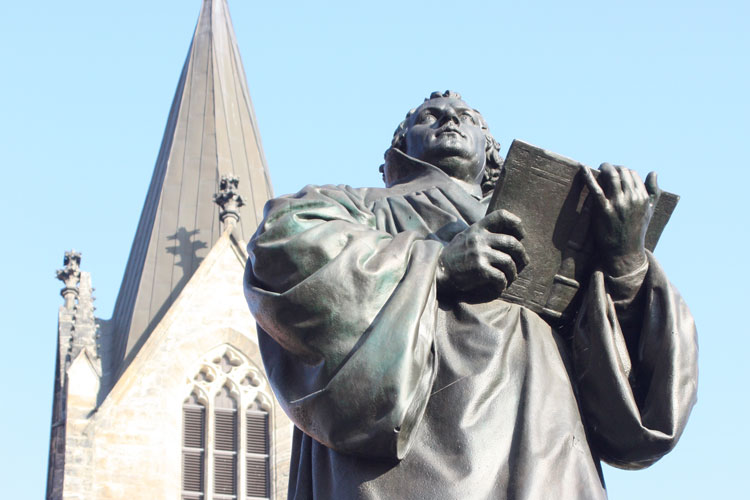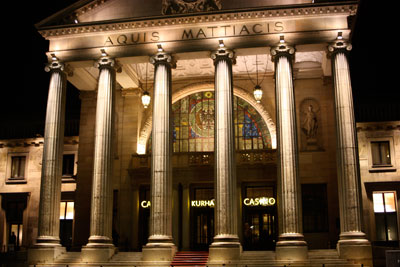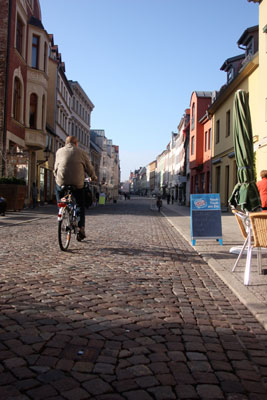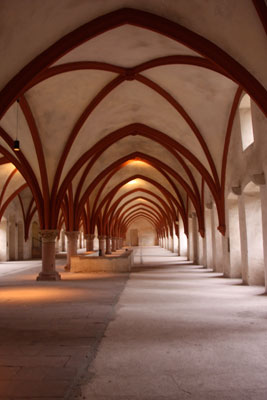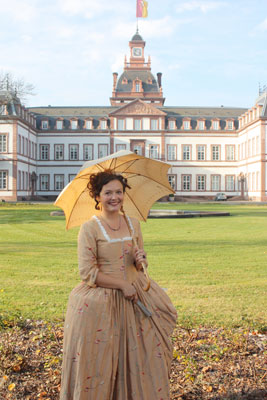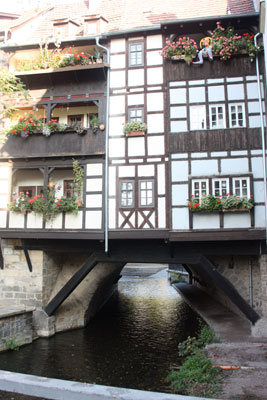An enlightening journey through Germany’s Luther Country
Debi Shank, ITN Staff
Every journey begins with a single step, and sometimes those steps turn into a leap of faith.
Five hundred years ago, a young Martin Luther embarked on a personal journey of faith that culminated in breaking the Roman Catholic Church’s power over all Christendom — putting a bounty on his own head in the process.
In October-November 2011 I had the opportunity to follow his footsteps, ready to discover more about the man who had such an impact on modern church history and the German culture as a whole.
Lutherstadt Wittenberg
My Luther journey began in Lutherstadt Wittenberg, the place where Luther taught, from both the pulpit and the university, and where he lived with his wife, Katharina von Bora, and their six children. Wittenberg is also where the Reformation began, on Oct. 31, 1517, when Luther nailed his 95 Theses to the wooden door of the Schlosskirche (Castle Church).
I was immediately taken by Wittenberg’s charm — half-timbered houses, cobblestone streets, the town square and, since it was fall, the changing leaves in shades of yellow, orange and red.
Our hotel, the Best Western Stadtpalais Wittenberg (Collegienstraße 56-57), was located on the eastern end of a pedestrian-only street within easy walking distance of many of Wittenberg’s historic sites. The first on our list was the Castle Church.
You can’t miss the church’s enormous, 88-meter-high tower with its spired dome. Also unmistakable are the large doors, bronze replicas dating from 1858 and overlaid with Luther’s 95 Theses in its original Latin. Inside the Gothic-style church, I was awed by the grandeur of the space.
Beneath the pulpit is Luther’s final resting place and, just steps away, that of his lesser-known but equally important counterpart, Philipp Melanchthon.
Formerly an Augustinian monastery, Martin Luther’s family home is now a museum filled with history of the Reformation. The living room remains as it was in his day, saved from plunder, we were told, because the door bore the scrawled signature of Peter the Great.
During our stroll through Wittenberg, I noticed several small, square, brass plaques laid amongst the cobblestone sidewalks. These were memorials placed in front of the homes where Jewish Holocaust victims had lived. We found similar plaques in other cities we visited.
Taking a detour from Luther history, we jumped into the 20th century with a brief but interesting look into the former East Germany (GDR), to which Wittenberg once belonged. The Haus der Geschichte (House of History) depicts nearly 50 years of life in the GDR.
The creaky, three-story building (Schlosstraße 6), a former kindergarten, houses examples of everyday living arrangements, each room a kitchen, living room or bedroom from the 1940s through the ’80s. (Admission costs €5, including an audio guide.)
Lutherstadt Eisleben
Lutherstadt Eisleben was not only Martin Luther’s birthplace, it was where he spent the last few weeks of his life.
Martin Luther’s birth house (Lutherstraße 15), now part of a much larger museum (entry, €4), has a variety of exhibits relating to the Luther family. Quite impressive was the room dedicated to his father’s profession as a copper miner. An example of a copper mine, in miniature, along with actual mining tools illustrates man’s ingenuity and resourcefulness.
Another impressive exhibit is that of the epitaph paintings. Biblical scenes painted on wood and, traditionally, placed in a crypt, these very large paintings each depict the family of the deceased, living and dead, along with the figure of Christ meeting the recently departed. Modern touch-screen displays help to explain the details and symbolism of each.
Also on display are a traditional baptismal font and the books and writings of Martin Luther.
Our museum tour culminated in a visit to Luther’s birth house, rebuilt in 1693 after the original was destroyed by fire.
Nearby is the church of St. Peter and St. Paul, where Luther was baptized; it was undergoing restoration at the time of our visit.
As we ambled down the cobblestone streets, I pondered the fact that I was walking on the very streets Luther traversed as he made his way, as did we, to St. Andrew’s Church, the last place he would preach prior to his death in February 1546 at the age of 62.
Weimar
Taking a brief reprieve from our immersion in all things Luther, we settled on the delightful gem of Weimar. Apparently, I wasn’t the only one smitten with this town, as evidenced by the number of people strolling the streets or enjoying a carriage ride through the historical old quarter.
At its Church of St. Peter and St. Paul, we stumbled upon a chorale rehearsal for a concert later that evening. The beautiful harmonies brought life into the old church, making me wish I had more time to soak in the music.
In need of a sweet treat and a cappuccino, we stopped at Residenz Café Weimar (Grüner Markt 4; phone 03 643 59 40 8) and sampled their sumptuous pastries before continuing down to the pedestrian-only shopping area on our way to the Deutsches Nationaltheater, where statues of native sons Schiller and Goethe stand watch.
A spiritual birth
Our journey through LutherCountry (the designated title for the states of Saxony-Anhalt and Thuringia) continued the next day in Erfurt, the capital of Thuringia.
It was in Erfurt where Luther lived as a monk in its Augustinian monastery. The church and monastery of St. Augustine (Augustinerstraße 10; phone +49 361 576 600) are open for tours (€3), and the church still conducts Sunday services.
Within the monastery’s museum is a magnificent library filled with original texts dating from Luther’s day, all carefully preserved behind protective glass.
One of the most interesting landmarks in Erfurt, tucked away on a cobblestone street, is the Old Synagogue (Waagegasse 8). Dating from 1100, it has undergone a number of alterations over the years, even being converted, in 1349, into a storehouse. It was these changes that made the building unrecognizable to the Third Reich as a synagogue, thereby saving it from destruction.
Now a museum, it houses an incredible display of ornate jewelry and engraved silver pieces, all of which were important to the culture and history of the Jewish community.
During an excavation at the synagogue in 1998, a sizable treasury was discovered, and those priceless coins are also on display. Self-guided audio tours are available for €5.
Into seclusion
In 1521, Martin Luther’s troubles seemed to be just beginning. Excommunicated from the church by Pope Leo X, he later appeared before a deliberative assembly at Worms, where he was ordered to recant the statements made in his 95 Theses and other works he authored. Luther refused, leaving Worms, and the emperor issued an edict demanding his arrest.
It was during Luther’s return trip home that he was “kidnapped” by arrangement of his good friend Fredrick the Wise and hidden away in Wartburg Castle.
Designated a UNESCO World Heritage Site in 1999, Wartburg was a grand fortress built around 1067. Perched above Eisenach, this walled castle was a delight to visit.
Original stone carvings and restored frescoes depicting the story of St. Elizabeth captured my attention, as did the Byzantine-style ladies’ room decorated in floor-to-ceiling mosaic tiles.
Visitors to the castle can take a 45-minute guided tour (€9) through the main castle rooms, followed by a self-guided tour through the museum with its impressive collection of armor, artwork and other treasures.
Upon exiting the museum, we followed a long, narrow walkway to the Luther Room, a spartan space where Luther lived as “Knight George” for 10 months. While in seclusion, he translated the New Testament from Greek into German.
Music to my ears
Luther wrote many hymns, some of which were recomposed by Johann Sebastian Bach. The Bachhaus (Frauenplan 21) in Eisenach was our next stop.
This historical house (admission, €7.50) contains musical instruments from Bach’s time, some of which are used in a live music performance included in the tour.
After wending our way through numerous exhibits relating to Bach’s life, including an impressive family tree with more than 70 members who were musically gifted, we ascended to the modern section of the Bachhaus. There, visitors can relax in suspended, cocoon-like acrylic orbs and, donning a pair of headphones, enjoy a Bach symphony.
On the main level, a gift shop offers visitors the opportunity to indulge in their appreciation for the famous composer.
Frankfurt and Mainz
Throughout the week, our group of 10 traveled by bus, mostly along scenic country roads, passing quaint little hamlets and historic buildings. Sometimes we journeyed on major highways, as we did on the two-hour trip to Frankfurt.
We left the small towns — and LutherCountry — behind and headed smack into the bustling metropolis of Frankfurt with its high-rise buildings and congested traffic plus, finally, some shopping.
We checked in at the newly opened and centrally located Jumeirah Frankfurt (Thurn-un-Taxis-Platz 2), where elegant chandeliers dripped with crystal, oversized local art adorned the walls, and mint- or lemon-infused water was available to guests to soothe a parched throat. And that was just the lobby!
After lunch at a local restaurant, we took a whirlwind bus tour of the city, ending at the huge town square, where preparations were already under way for its Christmas transformation.
The next day, we left the big city behind and traveled a short distance over the Rhine into Mainz. Donning rain parkas, we embarked on a brief walking tour that took us to the town square and St. Martin’s Cathedral, the site of the coronations of seven kings.
After a short walk from the cathedral, we arrived at the Gutenberg Museum (Liebfrauenplatz 5), something I had eagerly anticipated visiting, as my father owned a commercial printing company for years and passed his interest and knowledge on to me.
Johannes Gutenberg created what is known as movable type, that is, individual letters that could be put together in a block to produce a printed page, revolutionizing the printing process in Europe. Most importantly, his metal alloy type could hold up over multiple impressions, enabling the mass production of printed material. His model was the standard used for printing through the end of the 19th century, when other technologies proved to be more efficient.
Visitors can observe a live demonstration of Gutenberg’s typecasting process and possibly be chosen from the group, as I was, to print a a page from the Gutenberg Bible to keep as a souvenir.
Throughout the museum (entry, €5), a variety of printing presses are on display as well as exhibits that address all elements of printmaking, from papermaking to bookbinding. Of special significance is the vault on the third floor where, encased in glass, original Gutenberg Bibles and manuscripts are on display.
The Name of the Rose
Traveling through wine country, we stopped at Kloster Eberbach (Klosterverwaltung, Eltville am Rhein), a beautiful abbey that once was home to a Cistercian monastery. Self-guided (€5.50) and guided (€8) tours are available on an individual basis; wine-tasting tours (€15.50 per person plus a guide fee of €65) for groups of 10 people or more are also offered.
In every city and town we visited, the local tourist office provided wonderful tour guides who imparted a wealth of knowledge, often more than I could retain. For information on self-guided or guided tours, the tourist office is a great place to start. Here is a list of tourist offices for the cities we visited.
- Lutherstadt Wittenberg (Schlossplatz 2; phone +49 3491 4986 10)
- Lutherstadt Eisleben (Hallesche Straße 4; phone +49 3475 602124)
- Weimar (Markt 10; phone 03643 7450)
- Erfurt (Benediktsplatz 1; phone +49 361 66400)
- Eisenach (Markt 24; phone 03691 79230)
- Frankfurt (Römerberg 27; phone +49 6921 23 8800)
- Mainz (Brückenturm am Rathaus; phone +49 6131 28 6210)
- Wiesbaden (Marktplatz 1; phone 0611 1729 930)
- Hanau (Am Markt 14-18; phone 06181 1295 950 [website in German only])
A book I found helpful in preparing for this trip was Luther and the Reformation by Joseph A. Seiss, originally published in 1883 (republished by BiblioLife in 2008), which offered a historical record of Martin Luther. It is available as a free eBook on Kindle, iBooks, or the web.
We started our tour in the adjacent hospital building, built in 1220. It was hard to imagine this dark, dank building being a hospital as the aroma of old wine permeated the musty air. The high-ceilinged room was filled with old wine barrels, and in the darkness, which was pierced by the light from a few small windows and the illumination of candles, we gathered around a small table to sample some apple wine. A nearby cellar was filled with old vintages, some dating back to 1500.
Continuing on, we explored the monk’s dormitory, used in the 1986 movie “The Name of the Rose” with Sean Connery.
Looking down the long dormitory, I could see the optical illusion created by its design: the Gothic pillars dividing the room appeared to shrink the closer they were to where I was standing.
The basilica stood in sharp contrast to the dark hospital building. Although a chill was still in the air, the interior was bright due to the light coming through the south-facing leaded-glass windows.
Its magnificent acoustics were demonstrated as our guide indulged us in a brief a cappella performance. Not surprisingly, the basilica is used for classical concerts.
Wiesbaden
The spa town of Wiesbaden offered a much-too-brief respite for us weary travelers. As we walked to dinner, we saw the sights along the way.
At the Marktkirche (Haus an der Marktkirche, Schlossplatz 4), in the town square, a free 30-minute organ music recital is held every Saturday at 11:30 a.m. — a special treat. Listening to those pipes resonate through the cathedral gave me goose bumps. It is definitely a performance not to be missed.
Moving on, we paused briefly at Wiesbaden’s glorious, elegant casino, its exterior aglow against the dark sky. The ornately decorated rooms ooze glitz and glamour. Gents, be sure to pack your jacket and tie, as there’s a strict dress code.
We then made our way to the Kochbrunnen, where 15 hot springs come together beneath a pavilion-covered fountain. The 150-degree water, rich with sulfur and other minerals, is said to be good for digestion if consumed; I didn’t think it tasted bad, but others in our group weren’t as enthusiastic.
Hanau
It was our last day and time for our final destination, Hanau, located about an hour’s drive west of Wiesbaden.
We had time to tour only Philippsruhe, a spectacular Baroque palace that now houses the Hanau Historical Museum.
Situated on the Main River, this grand summer residence was designed in the opulent French Baroque style. The modern grounds, however, boast an English garden, part of a redesign done in 1880.
Two resting lions flanked the entry, and, awaiting us inside, a grand staircase was nearly dwarfed by the even grander artwork on the walls. The rooms reflected different architectural styles, featuring intricate woodcarvings from the Renaissance, ceilings dripping with Rococo embellishments and paintings reflecting the Classical period. Ornate chandeliers added to the splendor.
Unique to Philippsruhe is its paper theater museum, featuring small stages with often-dramatic backdrops — in their day the equivalent of our television. Paper figures were attached to sticks that were moved from side to side, animating the characters, while the operator provided narration.
Another section of the palace is dedicated to the Brothers Grimm, collectors of oral fairy tales and the compilers of the first German dictionary. Together, they gathered stories from peasants and villagers, eventually having enough material to publish two volumes.
A monument to them can be found in the Hanau marketplace, but a miniature one is on display at Philippsruhe.
Admission to the palace costs €2.50 per person.
Culinary delights
I think it goes without saying, when dining in Germany, that you should forget about dieting. I looked forward every morning to the excellent breakfast buffet offered, each with an amazing selection of bread, cheese, meat, cereal and yogurt. For lunch and dinner, nearly every meal we had was fabulous, but a few stood out above the rest.
In Lutherstadt Wittenberg, Brauhaus Wittenberg (Markt 6; phone 03 49 1 43 31 30, [website in German only]) brews its own beer. Although I did not partake, one group member highly recommended the beer with banana. For dinner, I enjoyed the Bierkutscherpfanne (pork shank with sauerkraut and fried potatoes), which cost €10.
Alt-Weimar (Prellerstraße 2; phone 0 36 43 8 61 90, [website in German only]) had an old-world setting with fabulous food. Our main course, butternut squash ravioli with truffles and wild cress, was followed by an equally satisfying dessert, an apple tart with almonds and currants. Entreés there run €11-€23.
At Hotel Eisenacher Hof (Katharinenstraße 11-13; phone +49 3691 29390) in Eisenach, we feasted, just as Luther would have done in his day. The medieval décor and rustic, wooden tables prime guests for a culinary event.
Our surly waiter greeted us with large “thimbles” of sweet apple liquor, followed by honey wine served from a spiral horn that was passed around the table. Beer and wine were served in clay tumblers that fit into holes carved into the table.
Appetizers consisted of seasoned pork fat and an herbed cheese spread plus a meat-and-potato soup. The main course was a long skewer of meat accompanied by potatoes, bread dumplings, fried onions and spätzle followed by dessert, a skewer of flambéed fruit.
The atmosphere, the camaraderie and the feast (€17.50-€19.50 per person, depending on group size) made this quite a memorable occasion.
Dinner in Frankfurt was in a much more sophisticated setting. The Jumeirah’s upscale Max on One restaurant (phone +49 69 297 237 0) didn’t miss a detail when it came to elegant dining, from the hot towels to wipe our hands with to the mid-meal palate-cleansing sorbet and the attentive servers who cheerfully fulfilled every request.
Our prepared menu was a feast for the eyes as well as the stomach, and our perfect meal was topped off with a dessert of flambéed fruit poured over a delicious sweet bread. A fixed-price multicourse meal there costs €98 ($132).
Summing up
LutherCountry has devoted a full decade to celebrating the impact this man had not only on religious thinking but on music, art, politics and society. Continuing through 2017, celebrations and exhibits will take place throughout the region. For details on events and their locations, visit www.visit-luther.com.
Debi Shank was the guest of the tourist boards of Saxony-Anhalt, Thuringia and the Frankfurt Rhine-Main region.

